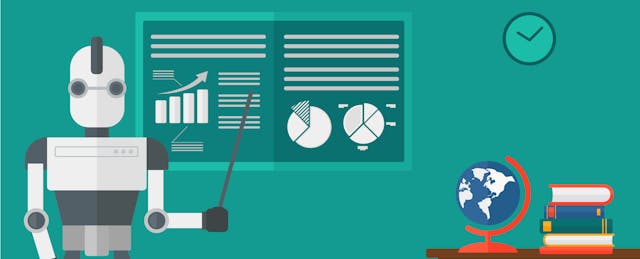It seems that every day we read about newer and better applications of artificial intelligence (AI) and machine learning (ML). Smart appliances that order groceries? No problem. Cars that drive themselves? Done. Need a good movie to watch? Better than your best friend’s last recommendation.
Estimates now suggest that up to 47 percent of U.S. jobs may disappear in the coming decades due the rise of automation. But at the same time, “spillover” effects will fuel the creation of entirely new industries and job categories. These statistics reflect one of the greatest challenges—and opportunities—for teachers in our seemingly paradoxical modern economy. How can we prepare a generation of students to adapt and evolve, learn (and un-learn), in an era where technological advances are transforming the world of work, traditional educational pathways are under fire—and the half-life of skills hovers around five years?
It’s a challenge that is complicated as the touchscreen generation enters middle school. Recall that the first iPhones weren’t released until 2007. iPads were introduced when today’s first graders were still in the womb. For the first time, many students are learning in classrooms equipped with access to broadband internet and mobile computing devices. And while emerging technologies may change the rules of the classroom (a bit), they also highlight fundamentally human aspects of teaching that are not replicable with AI and ML, yet critical to the success of today’s young learners.
A pat on the back, a nod at the right moment, praise given for habits and skills cultivated outside of the curriculum—all support learners in ways that are hard to measure and incredibly valuable. Great teachers have always known, and research now verifies, the role that learned behaviors like resilience and empathy play in our success. AI and ML can’t make learners feel safe, secure and confident. Only teachers can model and deliver these experiences.
The teachers that made learning come to life for me (thank you Mr. DePalma, Ms. Mackey, Sister Rachel) shared a passion for learning that opened the doors of my mind. It is something you see in their body language, feel in the tone of their voice and follow because passion is contagious and, at least for now, it’s very human. We know that students who have teachers that look like them, share backgrounds and teach well have significantly better outcomes than students that do not see themselves in teachers. Why? Role models give our students an important internal map on who they might be, how to do it and what success looks like.
What is often overlooked is what complicated little ecosystems classrooms are from a technological standpoint—dozens of learners, thousands of data sources that blend qualitative and quantitative outputs from both teachers and students. Machine learning can recognize patterns, make recommendations and process information at an incredible rate, but the data science applied in today’s classrooms is still narrow in scope compared to the science and art combined in the mind of a human teacher. Data collection and synthesis techniques aren’t available at the scale and consistency required for thoughtful classroom application. It will be some time before we can capture all a teacher can see, hear, and feel.
The most impactful applications of AI and ML in today’s classrooms act as a partner to the classroom teacher. ML can help less experienced teachers make better informed decisions about their students. It can process and spot patterns across homework assignments, or formative assessments. Predicting student struggles, identifying content, interpreting languages, and recommending interventions are all ways in which complex algorithms can make the work that teachers do more effective and efficient. Consider the well-documented story of average chess players with laptops partnering to defeat grand masters and supercomputers. ML can support early warning systems that reduce the likelihood that students fall through the cracks when class size—and expectations—increase.
And in the meantime, seemingly mundane (but extremely complex) subjects like data acquisition, interoperability and data science are laying the groundwork for a generational change in the way we organize learning; opening up expanded learning opportunities for today’s students. All of this is incredibly exciting and every day we learn more about how we can support teachers and students; however, one truth remains—there is no replacement for a great teacher.


